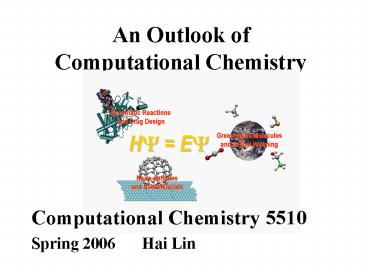An Outlook of Computational Chemistry - PowerPoint PPT Presentation
1 / 14
Title:
An Outlook of Computational Chemistry
Description:
Neglecting Certain Terms in Hamiltonian. Approximated Exchange & Correlation Functionals ... (Neglect the variational effects, non-classical recrossing, and ... – PowerPoint PPT presentation
Number of Views:133
Avg rating:3.0/5.0
Title: An Outlook of Computational Chemistry
1
An Outlook of Computational Chemistry
Computational Chemistry 5510 Spring 2006 Hai Lin
2
Biological Chemical Processes
Therapeutics Biotechnology
Na,K-ATPase
Bio-nano Device
Mechanism Dynamics
Energy
Influenza Virus
(Science 2004, 304, 1944)
New Drugs
Progress of Reaction
http//www.rkm.com.au/VIRUS/
HY EY
Experiment
Theory/Computation
3
What does Computational Chemistry Calculate?
- Energy, Structure, and Properties
- Energy
- Equilibrium geometry
- Dipole moment
- Orbital energy levels and electronic excitation
energy - Electron distribution (electron density)
- Electrostatic potential and atomic charges
- Vibrational frequencies (IR spectra)
- Ionization energy, electron affinity, and proton
affinity - Reaction path, barrier height, and rate constant
- Etc.
4
What Tools does Computational Chemistry Provide?
- Molecular Visualization (Graphic Representation)
- Molecular Mechanics (Classical Newtonian Physics)
- Semi-empirical Molecular Orbital Theory
- Ab Initio Molecular Orbital Theory
- Density Functional Theory
- Geometry Optimization
- Molecular Dynamics
Quantum Mechanical Methods
5
What Approximations does Computational Chemistry
Use? (MM)
- Ignore the changes in electronic structure.
- (Replace quantum mechanics by classical Newtonian
mechanics.) - Include only two-body effects for intermolecular
interactions. - (Many-body effects are accounted for in an
averaged fashion implicitly through
parameterization.) - Use simple math functions for energy
calculations. - (Assume parameters are transferable use harmonic
potentials for stretching and bending
interactions use Lenard-Jone potential for VDW
interactions use point charges to represent
charge distributions negelect polarization
effects.)
6
What Approximations does Computational Chemistry
Use? (QM)
Schrödinger Equation
Electronic Schrödinger Equation
Hartree-Fock Equations
Roothann-Hall Equations
Best Approximated (Lowest) Energy
7
What Approximations does Computational Chemistry
Use? (QM-2)
HF Theory
Neglecting Certain Terms in Hamiltonian
Represent Many-electon Wave Function by a Finite
Sum of Slater Determinants
Approximated Exchange Correlation Functionals
Semi-empirical Methods
Electron-correlated Wave Function Methods
Density Functional Theory
8
What Approximations does Computational Chemistry
Use? (Propety)
- Use harmonic approximation for vibrational
analysis and thermodynamic quantity computation. - Reduce the temperature to 0 K.
- (Use the static structure to represent the
molecule instead of the ensemble treatment with
the electric, vibrational, rotational, and
translational distribution of states at a
non-zero temperature.) - Calculate for a small number of particles and a
short-time scale. - (Experiments measure macroscopic properties.)
- Use transition state theory to determine rate
constants. - (Neglect the variational effects, non-classical
recrossing, and tunneling.)
9
What should I Do?
- Be aware of the merits and drawbacks of the
methods, select and apply the suitable techniques
to solve your chemical problems.
Full CI expansion Best many-electron WF
Complete CI expansion Exact solution to
electronic Schrödinger equation
Number of determinants
Complete basis set limit Best one-electron MO
HF
Minimum Basis set
Basis set size
10
How could I Do?
- Obtain results as accurate as possible with
reasonable compuational effort. - Keep balance between theory and basis sets.
- HF/6-31G(d), B3LYP/6-31G(d,p),
- MP2/6-311G(2df,2pd), CCSD(T)/cc-pVQZ
- Start with low-level theory to get preliminary
results, and refine the results with increasingly
higher-level calculations. - AM1 ? HF ? DFT ? MP2 ? CCSD(T)
- Geometry optimization at a lower level and
single-point energy calculations at a higher
level of theory. - CCSD(T)/cc-pVQZ//MP2/cc-pVTZ
- Test the level of theory on smaller compounds and
estimate the computational cost for your bigger
system. - Check convergency to make sure the numbers are
meaningful. - Practise, practise, and practise.
11
Outlook
- Higher Accuracy
- Combining several levels of theory with a few
empirical adjustments - Design of new density functional models
- Improvement of the quality of basis sets
- Go beyond the Born-Oppenheimer approximation
(e.g., spin-orbit coupling) - Advanced dynamic algorithms (e.g., tunneling
contribution) - Development of special techniques for a
particular purpose (e.g., energy conservation in
molecular dynamics, implicit solvation models).
12
Outlook (2)
- Bigger System
- Development of linear-scaling methods
- Development of combined QM/MM algorithms
- Development of efficient algorithms to sample
hyperspace. - More Diverse Applications
- Energy, geometry, IR spectrum, NMR shifting, rate
constants, ... - Gas-phase, liquid, solid, soft-materials ...
- Organic, inorganic, biological ...
- Environmental, medicinal, industrial, military
... - More user-friendly programs.
13
Summary
- Why do we need computational chemistry?
- What does computational chemistry calculate?
- What tools does computational chemistry provide?
- What should I do and how could I do?
- Outlook
- Higher accuracy
- Bigger system
- More diverse applications
14
Your Homework
- Prepare for the
- Report for paper analysis (2 4 pages)
- Oral presentation of your project (40 minutes
including questions) - Short paper for your project (3 5 pages)
Please turn in two reports on 5/11. Also email me
your power point file between 5/11 and 5/15.
Thank you for attending the class! I hope that
you have enjoyed it. Now I look forward to you
teaching me something next Thursday in your
wonderful presentation!

